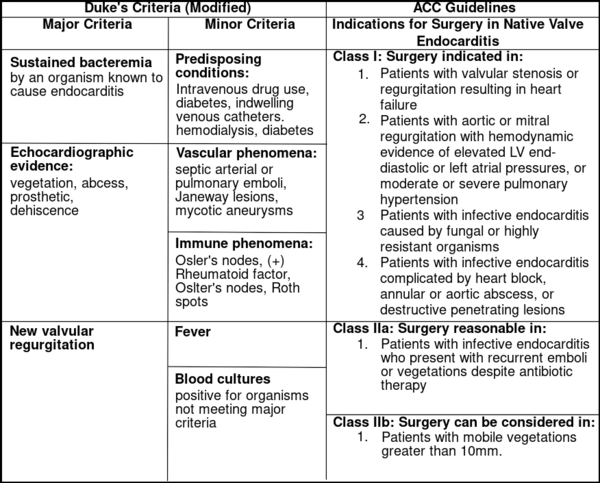Endocarditis: Difference between revisions
(Created page with "Endocarditis is an inflammatory reaction which will call at the heart valves . It can be divided in infectious and non -infectious causes , depending on whether there is a mic...") |
|||
| (5 intermediate revisions by one other user not shown) | |||
| Line 1: | Line 1: | ||
__TOC__ | |||
Endocarditis is an inflammatory reaction involving the heart valves. It can be divided into infective and non -infective causes, depending on whether there a micro-organism present in the process. There are several manifestations of endocarditis: | |||
Vegetation (most common and direct evidence of endocarditis ) | *Abscess Formation | ||
*Fistula formation | |||
*Vegetation (most common and direct evidence of endocarditis) | |||
{| class="wikitable" cellpadding="0" cellspacing="0" border="0" width="800px" | |||
|- | |||
|Video | |||
|Video | |||
|- | |||
!Vegetation on MV | |||
!Abscess after Aortic Prosthesis | |||
|} | |||
==Non-infective endocarditis== | |||
A non-infective endocarditis is rare. One form of this is Libman-Sacks endocarditis mentioned and is called in particular for those patients with lupus erythematosus and antiphospholipid syndrome. Non-infective endocarditis can also occur in some forms of cancer. | |||
==Infective endocarditis== | |||
In normal circumstances, the heart valves get a constant supply of fresh blood, rich in white blood cells that remove any infections. However in infective endocarditis, the heart valves do not get their supply of the white blood cells and thus cannot remove the infection. The valves for example can be damaged during rheumatic fever or after surgery. Inflammatory conditions in the mouth, for example due to poor oral hygiene, are also a major cause of endocarditis, because blood in that case sometimes is still in contact with the outside world, and the bacteria in the mouth of the patient. In that case, usually streptococcal species is found as a causative agent. If the access of the bacteria is located in the skin, such as in intravenous drug users, cultured staphylococci are often found in the blood. If valve replacement surgeries have taken place and artificial valves are made, it increases the risk of endocarditis. There too often skin bacteria are found.<cite>1</cite> | |||
==Diagnosis of infective endocarditis== | |||
One major and three minor criteria | {| class="wikitable" cellpadding="0" cellspacing="0" border="0" width="600px" | ||
|- | |||
!colspan="3"|[[Image:Dukes_criteria.svg|600px]] | |||
|- | |||
!colspan="3"|The diagnosis of infective endocarditis is made in the presence of at least: | |||
|- | |||
|Two major criteria | |||
|One major and three minor criteria | |||
|Five minor criteria. | |||
|} | |||
Click here for | ==Therapy== | ||
The treatment consists for infective endocarditis is prolonged administration of antibiotics via the bloodstream. If there is severe damage to the heart valve, or abscess formation around the valve, or there is of complications such as embolization of infected thrombi, surgical valve replacement will be needed. | |||
Click [http://www.webshop.hartstichting.nl/producten/producten.aspx?CatID=71&pID=3765 '''here'''] for research by Endocarditis prophylaxis committee of the Dutch Heart Foundation. | |||
==References== | |||
<biblio> | |||
#1 pmid=20223755 | |||
</biblio> | |||
Latest revision as of 09:40, 8 April 2014
Endocarditis is an inflammatory reaction involving the heart valves. It can be divided into infective and non -infective causes, depending on whether there a micro-organism present in the process. There are several manifestations of endocarditis:
- Abscess Formation
- Fistula formation
- Vegetation (most common and direct evidence of endocarditis)
| Video | Video |
| Vegetation on MV | Abscess after Aortic Prosthesis |
|---|
Non-infective endocarditis
A non-infective endocarditis is rare. One form of this is Libman-Sacks endocarditis mentioned and is called in particular for those patients with lupus erythematosus and antiphospholipid syndrome. Non-infective endocarditis can also occur in some forms of cancer.
Infective endocarditis
In normal circumstances, the heart valves get a constant supply of fresh blood, rich in white blood cells that remove any infections. However in infective endocarditis, the heart valves do not get their supply of the white blood cells and thus cannot remove the infection. The valves for example can be damaged during rheumatic fever or after surgery. Inflammatory conditions in the mouth, for example due to poor oral hygiene, are also a major cause of endocarditis, because blood in that case sometimes is still in contact with the outside world, and the bacteria in the mouth of the patient. In that case, usually streptococcal species is found as a causative agent. If the access of the bacteria is located in the skin, such as in intravenous drug users, cultured staphylococci are often found in the blood. If valve replacement surgeries have taken place and artificial valves are made, it increases the risk of endocarditis. There too often skin bacteria are found.[1]
Diagnosis of infective endocarditis

| ||
|---|---|---|
| The diagnosis of infective endocarditis is made in the presence of at least: | ||
| Two major criteria | One major and three minor criteria | Five minor criteria. |
Therapy
The treatment consists for infective endocarditis is prolonged administration of antibiotics via the bloodstream. If there is severe damage to the heart valve, or abscess formation around the valve, or there is of complications such as embolization of infected thrombi, surgical valve replacement will be needed.
Click here for research by Endocarditis prophylaxis committee of the Dutch Heart Foundation.
References
- Habib G, Badano L, Tribouilloy C, Vilacosta I, Zamorano JL, Galderisi M, Voigt JU, Sicari R, Cosyns B, Fox K, Aakhus S, and European Association of Echocardiography. Recommendations for the practice of echocardiography in infective endocarditis. Eur J Echocardiogr. 2010 Mar;11(2):202-19. DOI:10.1093/ejechocard/jeq004 |